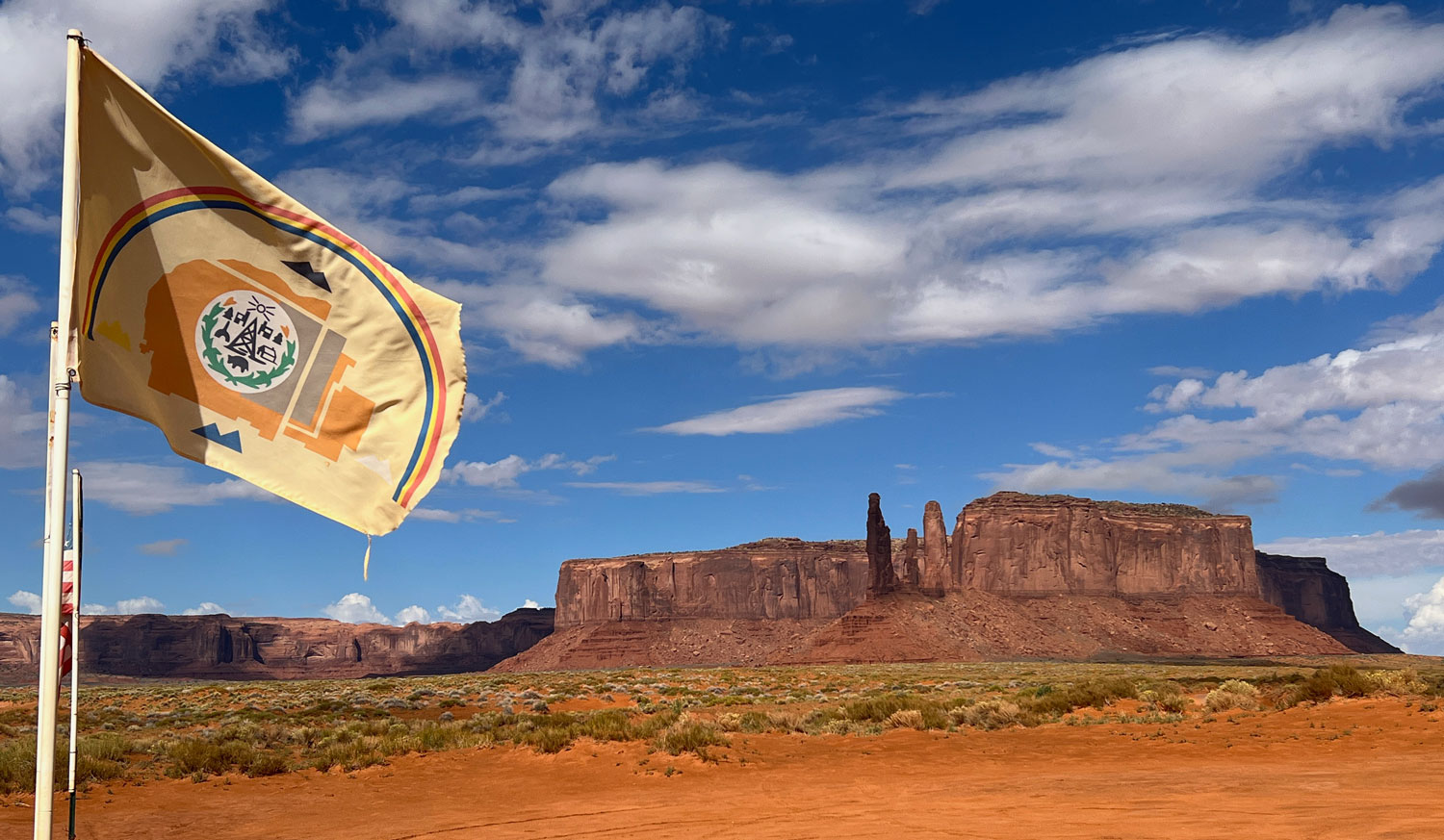Making Peace with Thanksgiving
Photos by Forrest and Donna Anderson
As a child, I had unruly dark hair that I kept in check by wearing it in two long braids. This made me a shoe-in to play an Indian in school and community plays because it meant that the harried teacher or mom in charge of costumes didn’t have to make a yarn wig with long black braids.
It was common the day before Thanksgiving for me to be wearing a construction paper headband and feather in school alongside pilgrims in wide construction paper collars and black hats.
This scene was played out in schools all over the United States and still is in some schools today. The central message is that the Pilgrims met for a nice harvest dinner with Native Americans, shared food, enjoyed each other’s company and we all lived happily ever until today when we still have sumptuous Thanksgiving feasts. We gather around the television to watch a football game that sometimes includes a team with a Native American name.
What could possibly be wrong with this picture? Most of American history, it turns out.
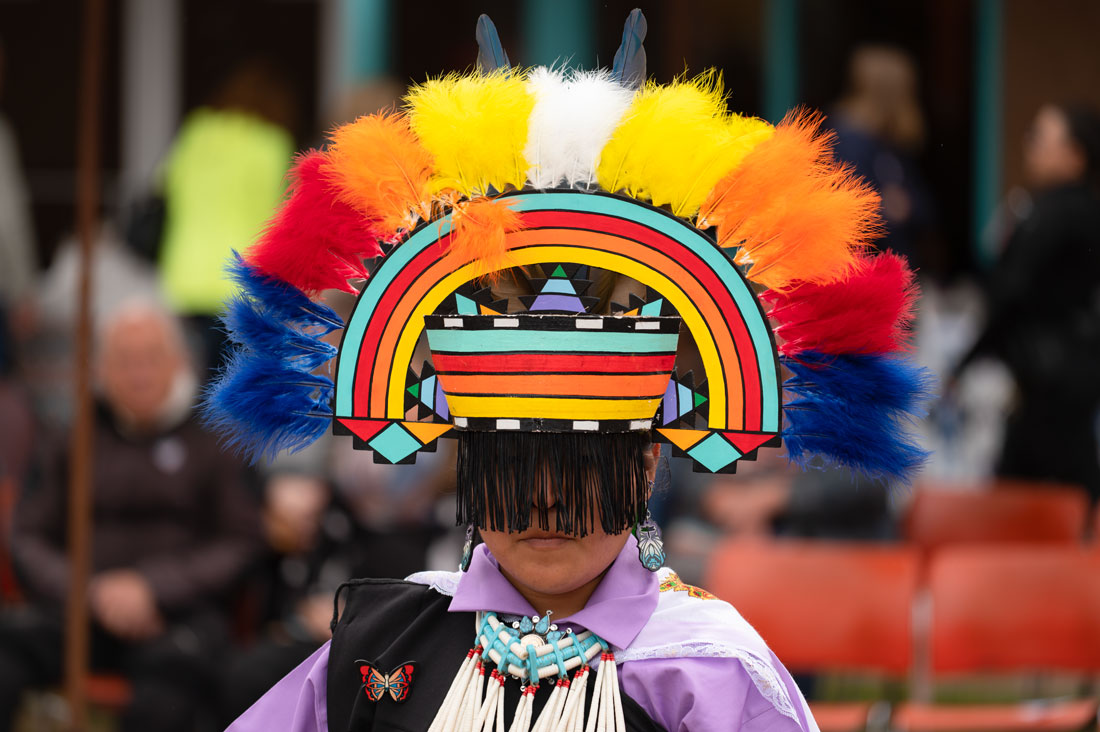
In many Native cultures, feathered headdresses are sacred regalia that are part of religious dances and ceremonies. They vary widely depending on a dance's purpose and the tribe. Many Native Americans resent stereotypical appropriation of this and other symbolic clothing.
The Thanksgiving myth has long stereotyped Native Americans, especially the Wampanoag tribe that was part of the original European-Native encounters. I was lucky enough to grow up with Native Americans as close family friends and knew that they were nothing like the Thanksgiving stereotype, but many Americans believe it throughout their lives.
Presenting Thanksgiving in this way trivializes America’s shared history and teaches an inaccurate view of it in, oh, so many ways.
Native Americans are a highly diverse segment of U.S. society that today are organized into 574 federally recognized tribes, each with their own traditions, cultures, and native languages. There never was a single Indian nation with representatives who met for a feast with early European settlers.
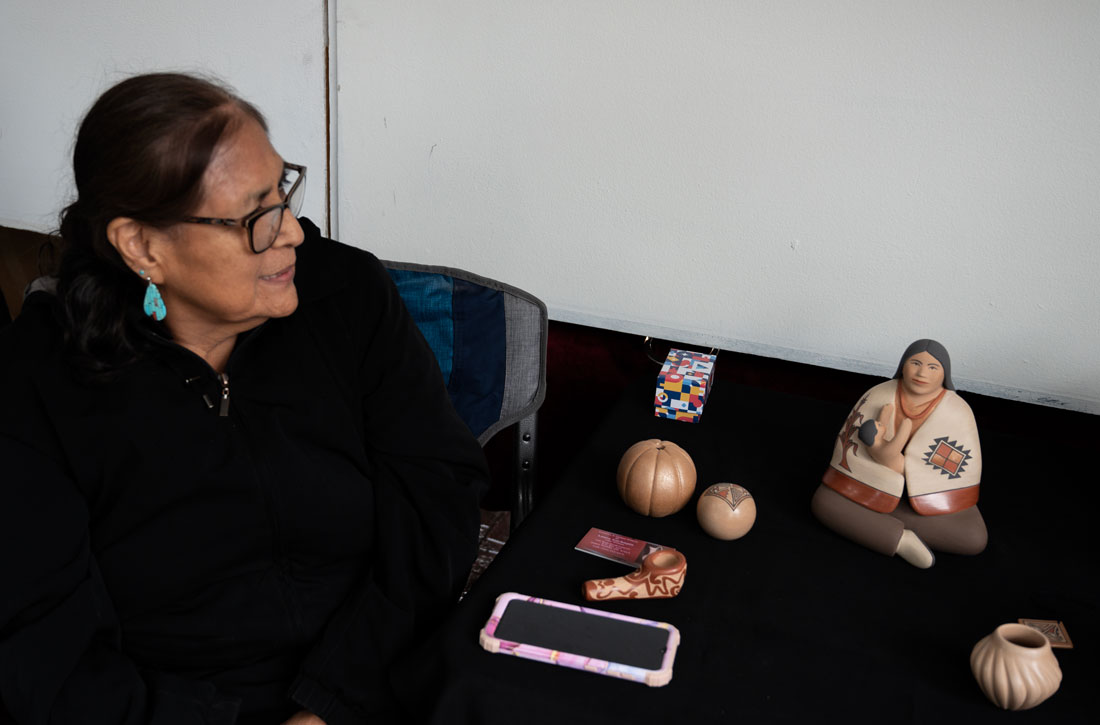
Laura Gachupin, Jemez, Mexico, is a Pueblo artist. Her culture is among hundreds of Native ones that are entirely distinct from Native cultures in the eastern United States.
More importantly, the history of Native encounters with European settlers was tragic from the beginning.
Before 1616, the Wampanoag peoples numbered 50,000-100,000 and lived in 69 villages in Massachusetts and Rhode Island. A devastating plague brought by European traders killed up to two-thirds of them and European traders kidnapped some of the survivors and transported them to Europe. The most well known was Tisquantum, otherwise known as Squanto. He was a member of the Patuxet tribe, one of 50 that formed the Wampanoag Confederacy. Spanish monks bought him in Spain and helped him get to England, where he worked for a shipbuilder and learned English. He returned home in 1619 as part of an exploring expedition on the New England coast, to find that his family, village and tribe had been wiped out in the plague.
Meanwhile, religious separatists fled from England to Holland and then North America to escape persecution. The Mayflower with some of them aboard dropped anchor in Provincetown Harbor in November 1620 and built a permanent settlement on the ruins of Squanto’s village, renaming it New Plymouth. The town turned out to be a precursor to the relentless European march across the North American continent that brought ruin to Native American communities along the way.
A 2015 paper by Roxanne Dunbar-Ortiz, author of An Indigenous Peoples' History of the United States, estimated that the population of indigenous people was 100 million in the Americas at the beginning of European colonization, which decimated it by 90 percent. Today, some 9.2 million Native Americans live in the United States.
The early European settlers, by their own accounts, initially survived by eating corn from abandoned fields and raiding Native villages and robbing them of their stored food and seed. One colonist wrote of the settlers robbing a Native grave. “The next morning we found a place like a grave. We decided to dig it up. We found first a mat, and under that a fine bow…. We also found bowls, trays, dishes, and things like that. We took several of the prettiest things to carry away with us, and covered the body up again.”
It was one of the first accounts of the plundering of Native graves, a practice that eventually filled museum storerooms with the remains of Native Americans and associated grave offerings. In 2020, some 116,000 Native remains were still in museums in the U.S., although many that have been identified as belonging to specific tribes have been returned to them and interred. Selected Native artifacts also are being returned to local museums and historical sites from major museums in the East where they were taken in the 19th and 20th centuries.
Back to Plymouth and the years 1620-21. Within a year of the landing of the Mayflower, half of the European settlers had died. This was another pattern that became common as Europeans advanced across America. After removing Native Americans from their land, many newcomers often were unsuccessful at cultivating the lands and abandoned or sold them. This is one reason that vast stretches of the United States that were taken from Native Americans are today uninhabited. To many Native and non-Native peoples, this has been a ludicrous and entirely unnecessary waste when proper land and resource management would have enabled both groups to co-exist.
In Plymouth, the surviving Wampanoag saw the Mayflower passengers as peaceful because they included women and children, but they still didn’t approach them the first winter. Samoset, a Monhegan from Maine, went to the village on March 16, 1621. The next day, he returned with Tisquantum, who showed the settlers how to plant corn, fish and gather berries and nuts. He became an interpreter and emissary between them and the Wampanoag Confederacy. The settlers and Ousamequin (Massasoit), the Grand Sachem of the Wampanoag Confederacy, made a mutual defense pact.
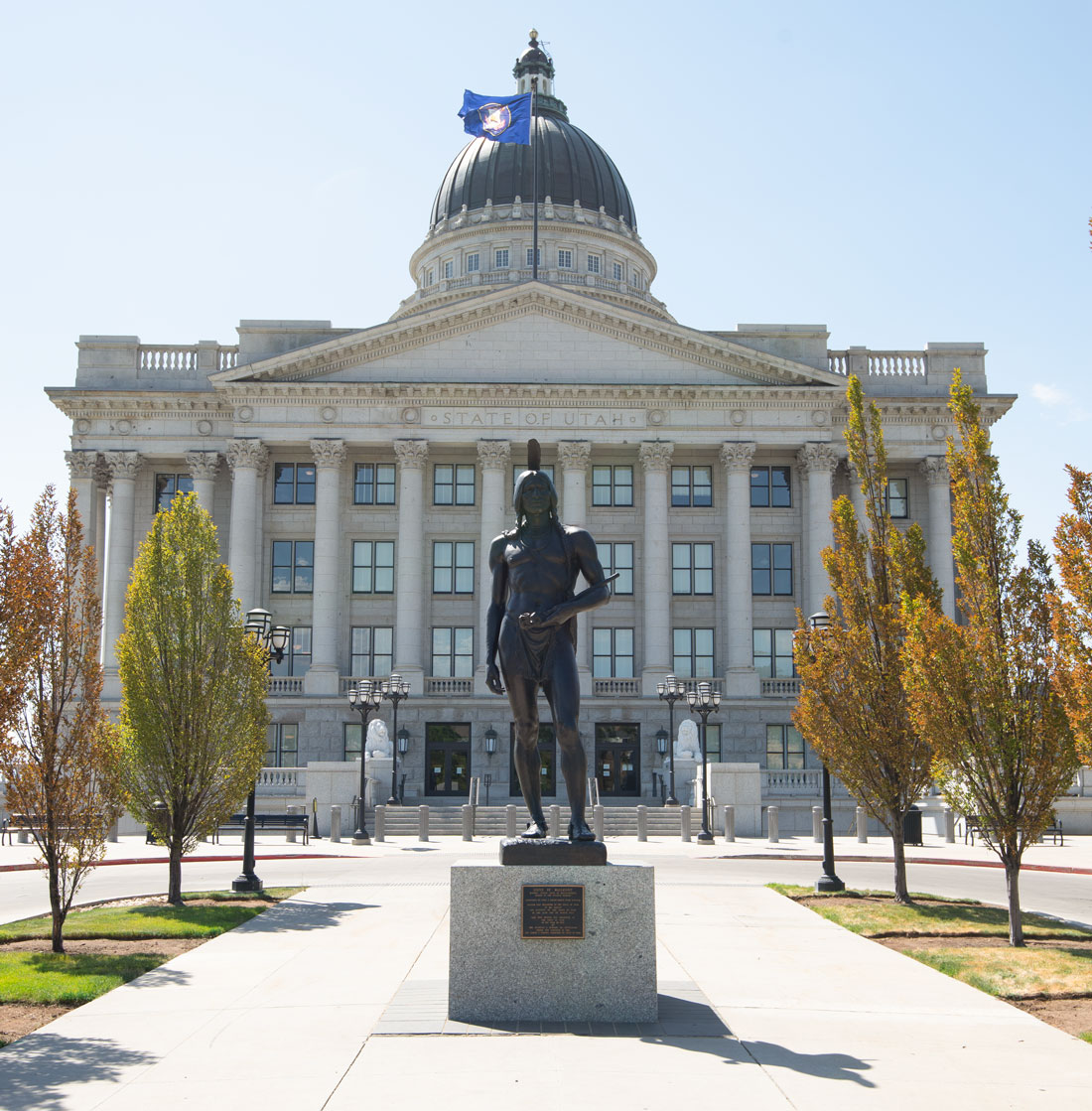
A statue of Massasoit at the Utah State Capitol in Salt Lake City. A number of these statues exist, including one at Plymouth, Massachusetts. Many Native Americans have ambivalent or negative feelings about Massaoit's pact with the early European settlers.
In the fall of 1621, the Pilgrims had a good harvest. One of the settlers, Edward Winslow, wrote a letter to friends in England, dated Dec. 11, 1621. He described harvesting 20 acres of Indian corn and six acres of barley and peas, and fertilizing the ground with herrings in the Native fashion. “…our harvest being gotten in, our governor sent four men on fowling, so that we might after a more special manner rejoice together, after we had gathered the fruit of our labors.”
“…amongst other recreations, we exercised our arms, many of the Indians coming amongst us, and among the rest their greatest King Massasoit, with some ninety men, whom for three days we entertained and feasted, and they went out and killed five deer, which they brought to the plantation and bestowed on our governor, and upon the captain, and others. And although it be not always so plentiful, as it was at this time with us, yet by the goodness of God, we are so far from want, that we often wish you partakers of our plenty.”
Some historians believe that in the context of the Wampanoag Confederacy’s extensive inter-tribal ties, this was more of a diplomatic occasion than a feast of friends and that Massasoit and his men may have shown up because they heard gunfire and thought the Europeans who they had sworn to aid were being attacked.
In any case, the cordial relations didn’t last. In 1636, a white man was found slain in his boat and the Pequot were blamed. In retaliation, European settlers from three colonies and allies from other Native tribes burned Pequot villages and massacred 400-600 women, children, and elderly men while their warriors were away. English Major John Mason, who was in charge of the massacre, reported: “We must burn them! Such a dreadful terror let the Almighty fall upon their spirits that they would flee from us and run into the very flames. Thus did the Lord judge the heathen, filling the place with dead bodies.”
William Bradford wrote: “Those that escaped the fire were slain with the sword; some hewed to pieces, others run through with their rapiers, so that they were quickly dispatched and very few escaped. It was conceived they thus destroyed about 400 at this time. It was a fearful sight to see them thus frying in the fire...horrible was the stink and scent thereof, but the victory seemed a sweet sacrifice, and they gave the prayers thereof to God, who had wrought so wonderfully for them.”
The day after the massacre, Massachusetts Bay Colony Governor John Winthrop declared a day of celebration and thanksgiving for the subduing of the Pequots. This English thanksgiving tradition was a long-standing post-battle tradition in which troops fasted and prayed to give thanks for their victory in battle. It wasn’t an occasion for a merry feast.
An estimated 300,000 Native Americans were killed throughout New England in similar incidents over the next few decades. The Pequot tribe was almost entirely wiped out.
Since 1970, Native Americans from the area around Plymouth have met annually at Cole’s Hill which overlooks Plymouth Rock for a National Day of Mourning at Thanksgiving time. The tradition began when Wampanoag Wamsutta (Frank) James was invited to speak at a celebration of the 350th anniversary of the Pilgrims’ arrival. When the event organizers found out that his speech highlighted the atrocities and broken promises that his people had endured, they canceled the invitation.
James’ speech characterized Massasoit’s pact with the Europeans as “perhaps our biggest mistake. We, the Wampanoag, welcomed you, the white man, with open arms, little knowing that it was the beginning of the end.”
Frank James went to Cole's Hill and gave the speech instead. Today, a small metal plaque is affixed to a stone on that spot to commemorate the speech and what Thanksgiving means to indigenous people.
The frenetic shopping day that most Americans know as Black Friday also is called National American Indian Heritage Day, part of Native American Heritage Month in November. The day commemorates the survival of Native cultures in the face of such massacres, theft of their lands, and centuries of forced cultural assimilation. It also is a protest against prejudice that Native Americans continue to experience and sometimes is combined with protests against specific initiatives such as infrastructure encroachment on sacred Native lands.
How did we conflate our modern Thanksgiving feast with the fraught history of the European colonization of America? The long-standing Native American tradition of an autumn thanksgiving feast was adopted by some Europeans along the east coast over succeeding centuries after the Mayflower landing. It was simply a day to express gratitude. George Washington, himself a veteran of Indian wars, declared November the official Thanksgiving Day during the Revolutionary War. Native Americans fought on both sides of this war.
In 1863, in the midst of the Civil War and in an attempt to unify the nation, Abraham Lincoln declared Thanksgiving a national holiday. Sarah Josepha Hale, author of Mary had a Little Lamb, editor of an influential women’s magazine called Codey’s Lady’s Book and an acquaintance of Lincoln’s had long pushed for making the feast a national holiday. She described a New England Thanksgiving dinner with turkey and other meats in her book Northwood, the first published by a woman in the English language in the Americas. However, it wasn’t until the late 19th century that the so-called Pilgrims came to be called that, were brought into Thanksgiving, and were incorporated into standard elementary school education.
Dr. Arthur C. Parker, a Seneca who was the director of the Museum of Arts and Science in Rochester, N.Y. persuaded the Boy Scouts of America to set aside a day for the first Americans. Red Fox James, a Blackfoot, rode horseback from state to state seeking approval for a day to honor Native Americans. On December 14, 1915, he presented the endorsements of 24 state governments at the White House. In 1915, the annual Congress of the American Indian Association also called for an American Indian Day. The first American Indian Day in a state was declared on the second Saturday in May 1916 by the governor of New York. Several states celebrate the fourth Friday in September and several have designated Columbus Day as Native American Day.
In 1990, President George H. W. Bush approved a joint resolution designating November 1990 “National American Indian Heritage Month.” Similar proclamations have been issued each year since 1994.
Before dawn on the day after Thanksgiving, many Native Americans take a ferry to Alcatraz Island in San Francisco Bay, where Native dancers perform and crowds watch the sun rise and remember the 1969 Native American occupation of the island. The event commemorates the 1969-1971 Native American occupation of the island and its demand that the island be turned into a Native American cultural center and school.
Native Americans today have diverse ways of observing Thanksgiving and a wide spectrum of opinions about it, although the general consensus is that the Thanksgiving myth masks the country’s history of violence against Native populations and perpetuates demeaning stereotypes. Some celebrate Thanksgiving as a Native celebration that grew out of the fall harvest feast that some tribes observed probably for millennia – a time to give thanks for the harvest, family and friends. They don’t think Native Americans should give up the holiday just because white America has painted a different meaning on it. Giving thanks daily to the Creator is a strong tradition that permeates many Native cultures in their dance, song, stories, and art.
Some tribes and communities hold traditional ceremonies with dances, prayer and song at Thanksgiving, and teach young people stories from the rich oral history of their tribes, Native arts and skills, and about traditional Native foods. Some say they celebrate that after all that has happened to their people, they have survived and retained the cultures that make them who they are.
Thanksgiving isn’t the only holiday that many Native Americas celebrate in different ways than most Americans do. For some Native tribes, July 4th is a time of traditional homecoming and Native dances.
Many Native Americans, like other Americans, enjoy Thanksgiving as the beginning of the holiday season, with good food, football, family, and pumpkin pie. Others avoid celebrating on the day and spend it in other self-affirming activities or observe it as a day of mourning.
Many Native Americans have painful memories of paper Indian costumes and fake feathers that they believe mocked clothing sacred to some Native religions and cultures and of being singled out as the designated Indian in school at Thanksgiving. Others say their parents kept them out of school on that day or insisted that the schools not hold such activities.
Many teachers are aware of the problems with the traditional Thanksgiving story and fear offending Native Americans by teaching it. The solution, say Native American activists, is not to stop teaching about it but to teach the truth. They believe that the following should be taught to school children and that Thanksgiving is an opportunity to do so:
- The notion that the European colonization of the United States was peaceful and good for everyone should be dispelled. Not just the English but other European cultures oppressed Native Americans for hundreds of years.
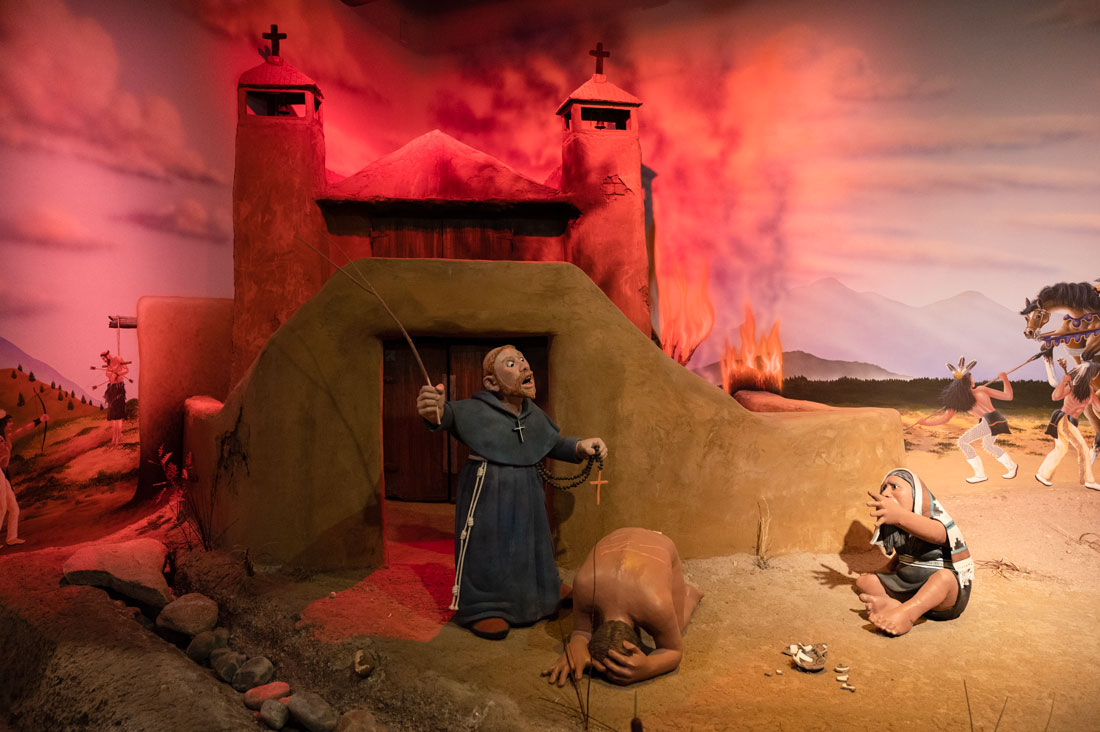
These sculptures by Roxanne Swintzell at the Poeh Cultural Center in Pojoaque, New Mexico, depict Spanish oppression of Native Americans in the area.
- The Pilgrims shouldn’t be placed in the starring role with nameless, faceless Native Americans as guests. The true story about the critical Native contribution to the United States should be told – that the Wampanoags had a sophisticated society that had lived in the Plymouth area for thousands of years, with their own culture, government, religious beliefs and languages. That society gave thanks as a daily practice as well as holding autumn harvest feasts that eventually developed into Thanksgiving feasts among European Americans.
- The Wampanoag were just one of thousands of Native American communities and nations across America that are an integral part of the American story. All Americans live on land that was once Native, and Native presence goes back thousands of years. The history of the United States is the history of interactions between Native cultures and immigrants from other nations that have changed all of those cultures. The Native story is quintessentially American and should be an integral part of efforts to instill in children a love for their country.
- A vast Native trade network of trails and routes long existed in the Americas before the Europeans arrived. Europeans survived because they used the Native economy and network as they moved across the continent. Today, archeaological ruins, major highways, place names, cultural references, words, and popular foods draw on that Native world. European “discoveries” in the United States were new to Europeans, but not to Native peoples.

Chaco Canyon, one of the United States' premier archaeological sites.
- Native Americans were successful hunters, farmers and fishermen who were knowledgeable about weather patterns, animals, farming, water, the seasons, and astronomy. Out of this interaction with the environment came a culture of gratitude for water and food that they grew and gathered and animals they hunted. Their ceremonies, songs, dances and feasts thanked those animals and plants, especially important ones for their sustenance such as salmon and bison. The Yakama people in Washington State call themselves the salmon people and hold a ceremony in spring to welcome the salmon as they migrate up the Columbia River to spawn. They have long passed on knowledge about how to care for the salmon so that they will continue to do so. Hydroelectric dams and overfishing have caused the salmon population to drastically decline, and the Yakama today are involved in efforts to restore them. The Lakota honor the bison which once provided nearly everything they needed. Many other tribes celebrate and honor corn as the basis of their diet.
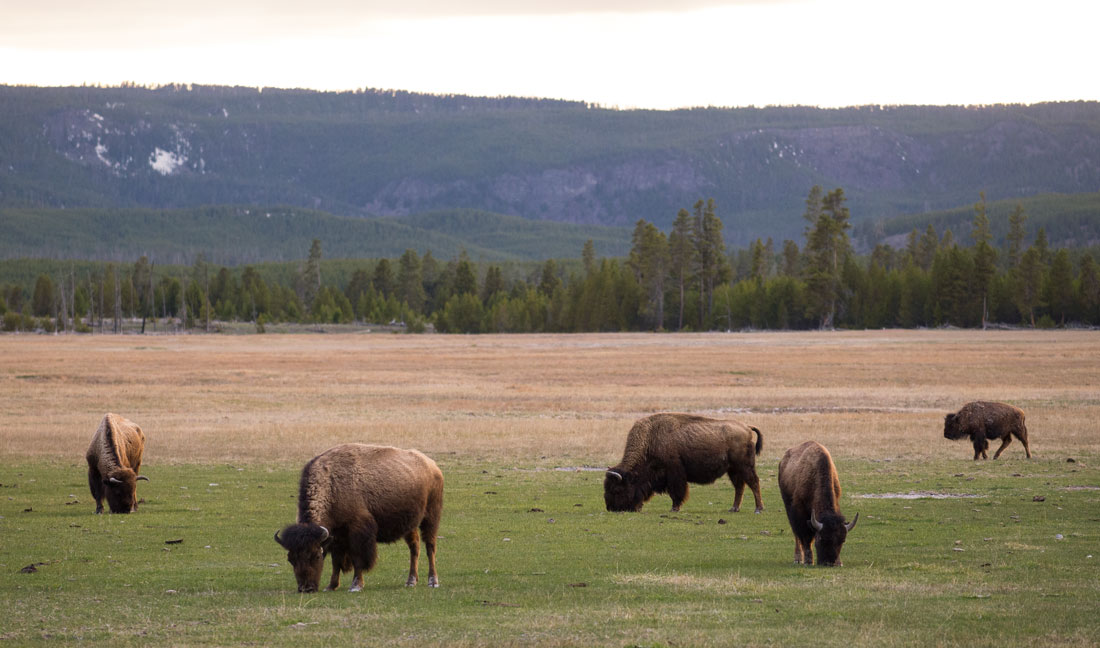
A protected bison herd in Yellowstone National Park, Wyoming.
- Many Native tribes believe that they are caretakers of the relationship between them and nature and are intimately related to it, and that they have a deep responsibility to practice resource management to keep the environment in balance. Environmentalists are acknowledging the benefits of this knowledge and drawing upon it to combat the climate crisis.
- Native tribes are highly communal, joining together to hunt, fish, and farm. They passed their skills down from generation to generation through example, telling stories, ceremonies and songs that honor animals, crops, fish, and sustaining foods. Some Native Americans say they particularly take the time at Thanksgiving to think of the homeless, those who are hospitalized or in nursing homes, those who are incarcerated, soldiers who are overseas, those who are mourning and travelers.
Europeans brought disease, war, genocide, dispossession from land that indigenous people had used for thousands of years, federal policies aimed at wiping out Native culture and ways of life, overharvesting, pollution, and a reduction of wilderness habitats that impacted Native ability to grow, gather or hunt traditional foods.
Because processed foods have brought high levels of diabetes and other health problems to Native communities, some tribes are promoting a revival of native food culture. Native peoples introduced the colonists to the concept of plants growing together through companion planting. The plants that many Native tribes call the Three Sisters and revere as the foundation of their farming – corn, beans and squash – benefit from companion planting. Beans climb the corn stalks and replenish the soil with nitrogen. The corn’s leaves protect the beans from the sun. Squash planted between the corn plants holds moisture in the soil and discourages weed growth and insect infestation. The traditional Thanksgiving meal is made up of indigenous Native foods – turkey, potatoes, pumpkins and squash, green beans, corn, cranberries, berries, corn, vanilla, chocolate and even sugar.
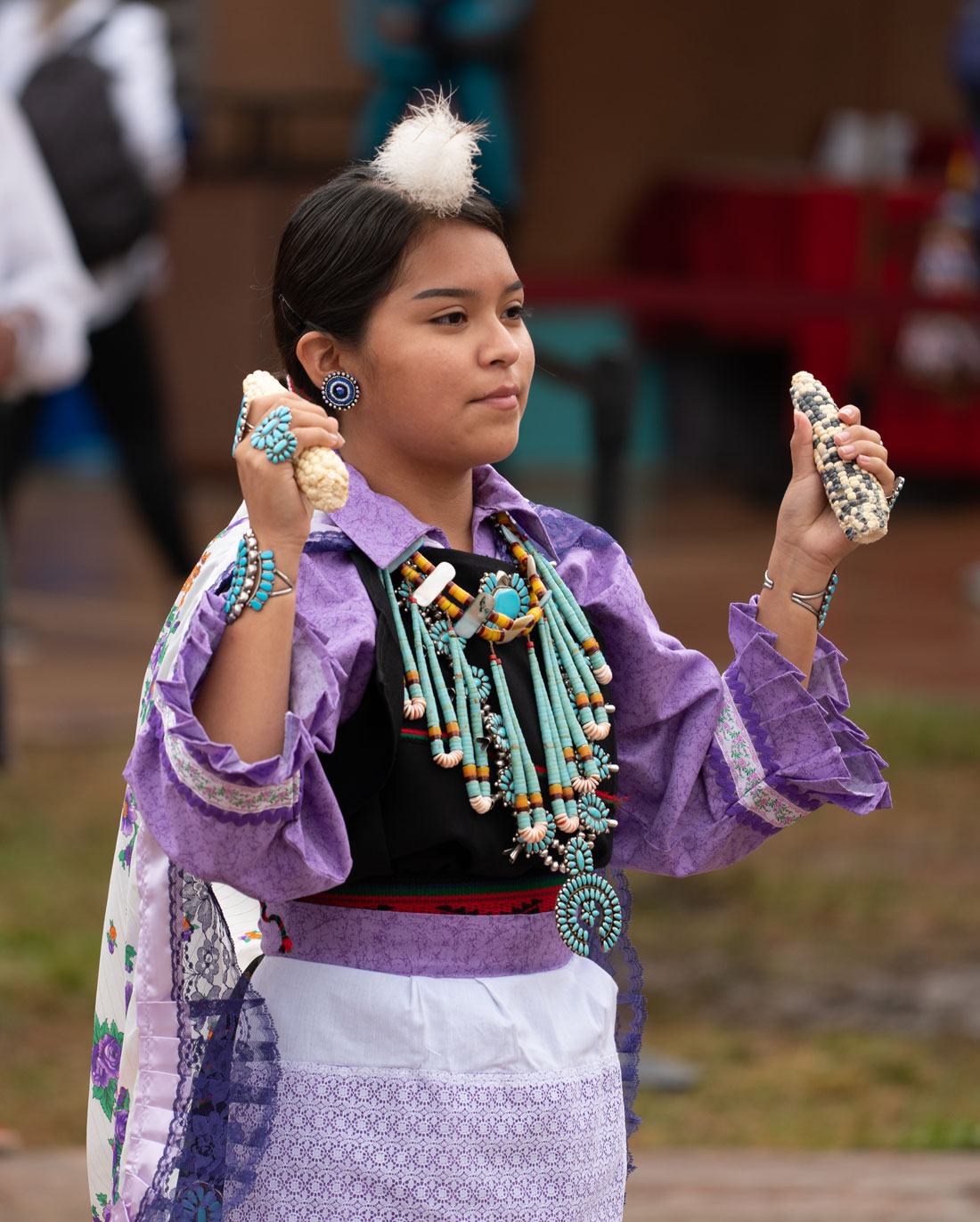
A dancer performs a dance in thanksgiving to the corn, the primary crop that has sustained Native tribes for thousands of years. Pueblo Cultural Center, Santa Fe, New Mexico.
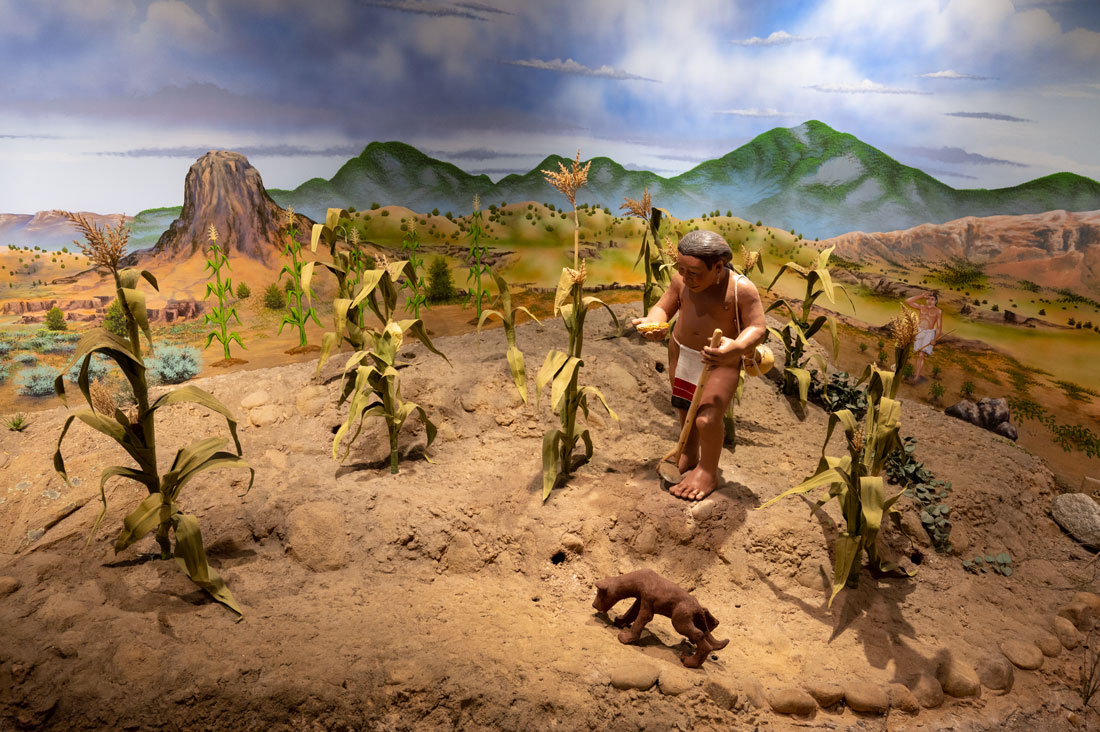
Pueblo artist Roxanne Swintzell's superb sculptures at the Poeh Cultural Center in Pojoaque, New Mexico, illustrate the central position of corn in Southwestern agriculture and cuisine.
Native Americans haven’t disappeared. They live modern American lives while retaining their age-old traditions. They have survived for thousands of years by constantly adapting, a skill all Americans need to cope with current issues.
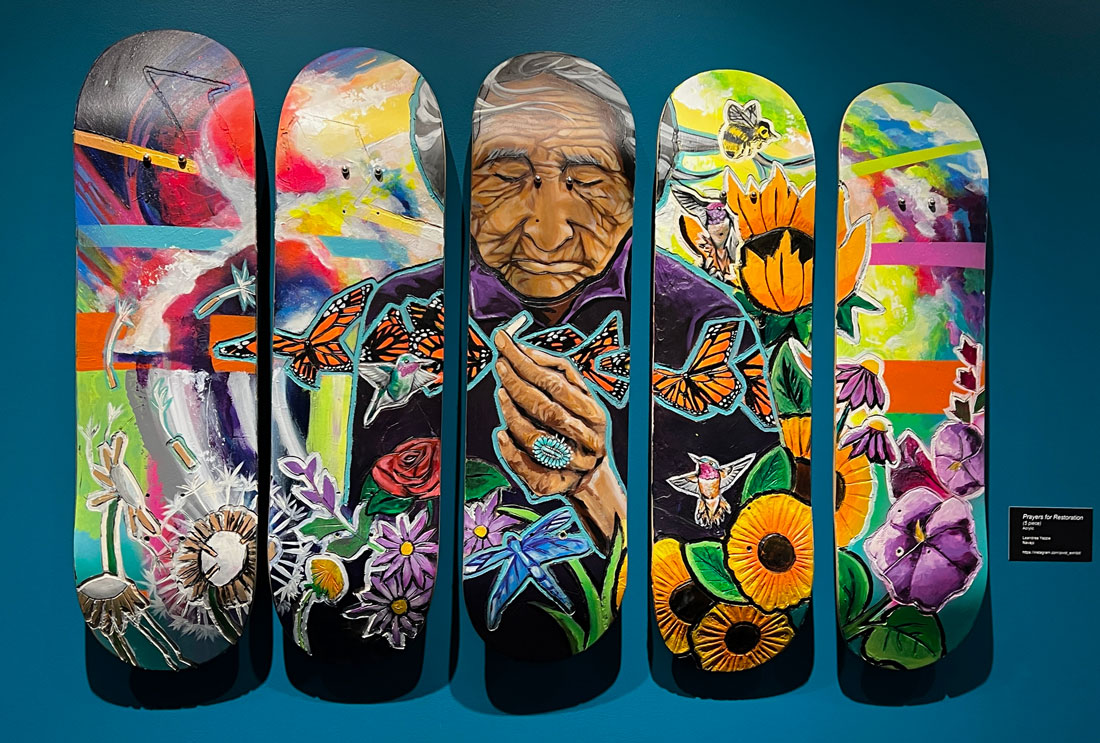
Modern Native American art on skateboards, Pueblo Cultural Center, Santa Fe, New Mexico.
Native Americans have diverse cultures, languages, and beliefs. There never has been just one Native American culture.
The United States has ratified more than 370 treaties with Native American nations, many of which have not been honored. These treaties continue to impact the country today.
What can you do to support Native people?
Recognize the contribution of Native peoples in every major part of American history – the American Revolution, the Civil War, World Wars I and II, the U.S. military today, and the general shaping of American history. One way to do this is to find out about Native peoples who have long populated the area where you live. Almost every place in the United States has native history.
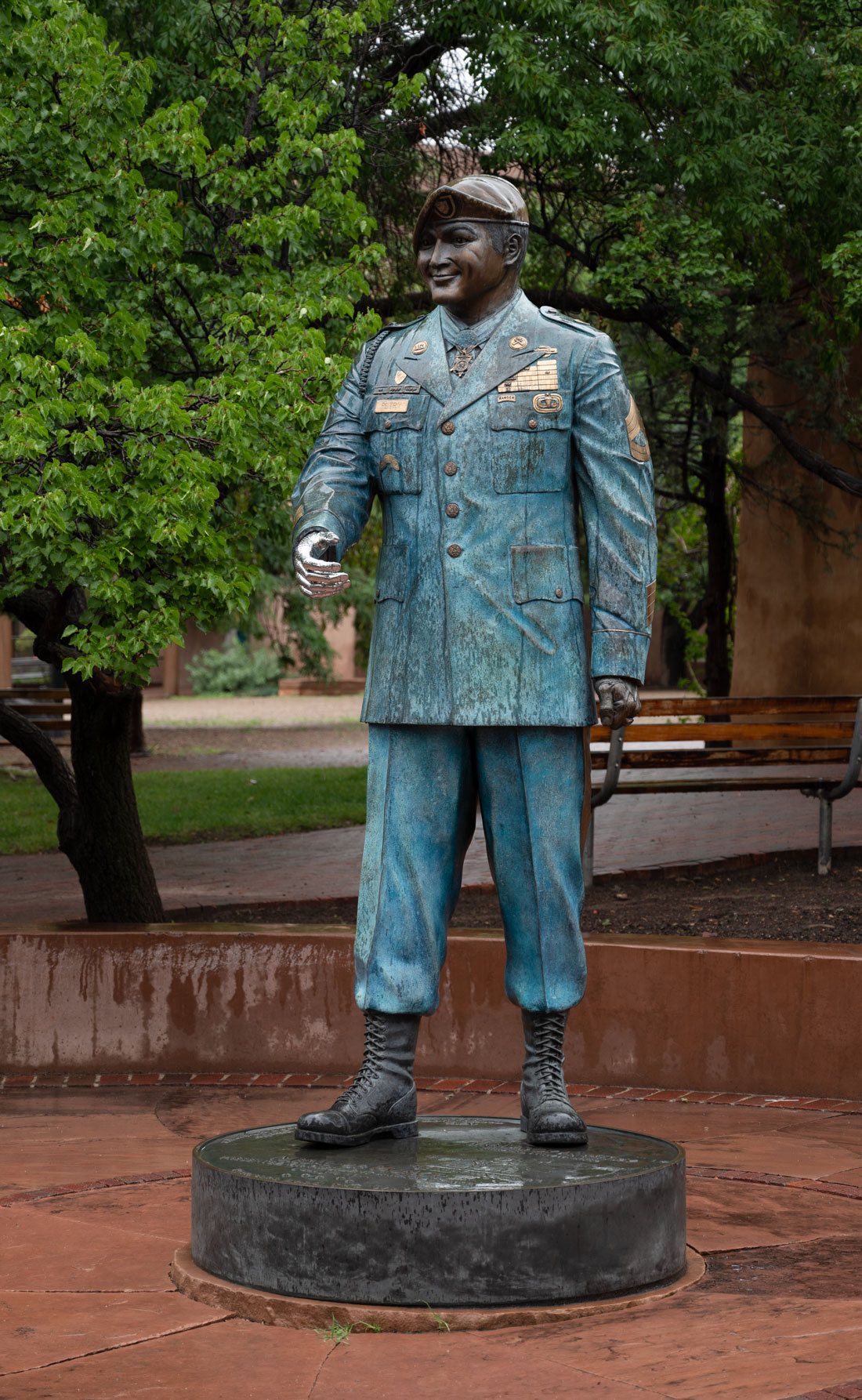
Statue of Native American soldier Leroy Petry, who was wounded in Afghanistan while heroically defending fellow soldiers. The silver hand represents a prosthetic hand, as Petry lost his right hand when he picked up a live grenade and flung it away from the other soldiers, saving their lives.
Visit Native American historical sites. There are dozens of them, including some of the finest archaeological sites in the world. Attend Native cultural events where possible.
Native American teachers recommend teaching the story of Native genocide factually, even to elementary school students, making it clear that it wasn’t their fault regardless of their race and discussing with students how the same mistakes can be avoided going forward.
Don’t perpetuate stereotyped, simplistic views of Native culture. Instead, incorporate Native knowledge through teaching about Native art, culture, stories, skills, and foods. Be tribally specific and accurate.
Support the work of Native American authors, activists, artists, and chefs.
Donate to reputable Native American organizations that are seeking to help Native nations. These nations face daunting challenges – poverty, unemployment, discrimination, inadequate education, lack of water and other natural resources, kidnapping of women by non-Natives, encroachment on their land and sacred sites, death from disease at higher rates than other ethnic groups, a continuing struggle to preserve their cultures, art and languages, lack of broadband access in a world dependent on it, and disproportionate impact from climate change.
The 2022 Proclamation on National Native American Heritage Month acknowledged that “America has not always delivered on its promise of equal dignity and respect for Native Americans. For centuries, broken treaties, dispossession of ancestral lands, and policies of assimilation and termination sought to decimate Native populations and their ways of life. But despite this painful history, Indigenous peoples, their governments, and their communities have persevered and flourished. As teachers and scholars, scientists and doctors, writers and artists, business leaders and elected officials, heroes in uniform, and so much more, they have made immeasurable contributions to our country’s progress.
“We must do more to ensure that Native Americans have every opportunity to succeed and that their expertise informs our Federal policy-making,” the proclamation says.
As we gather for Thanksgiving, it’s high time we thanked the Native peoples upon whose foundational culture, infrastructure, resources and cuisine our country was built.
Check out these related items
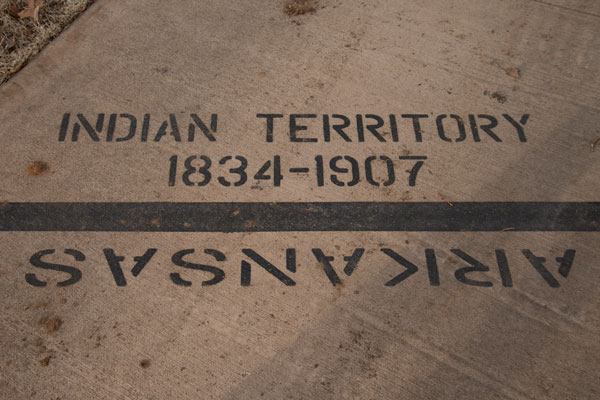
Nations Within a Nation
The first Native American to become U.S. interior secretary must deal with a fraught history of government-Native American relations.

Santa Fe’s Indian Market
The Santa Fe Indian Market, started a century ago to save Native American culture and art, is the largest Native American event in North America.
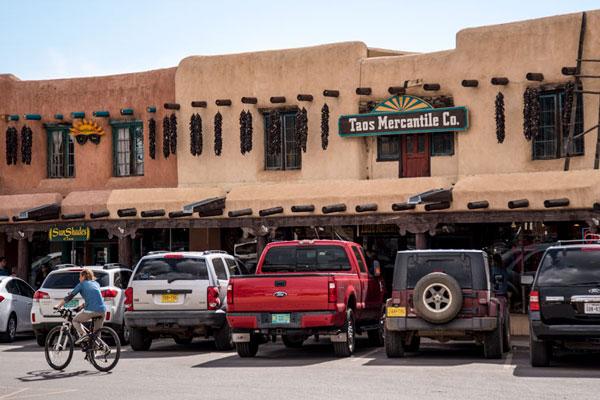
The Booming and Broiling Southwest
The American Southwest is the fastest growing region in the United States, but also the hottest and most arid.
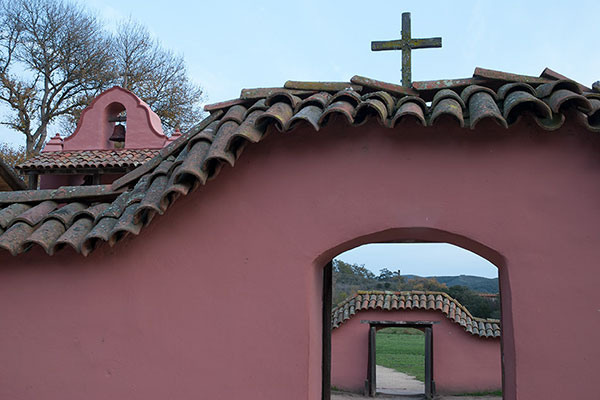
The Land of Junipero Serra
Junipero Serra's "sainthood" is controversial, but the extent of his cultural impact on California is indisputable.
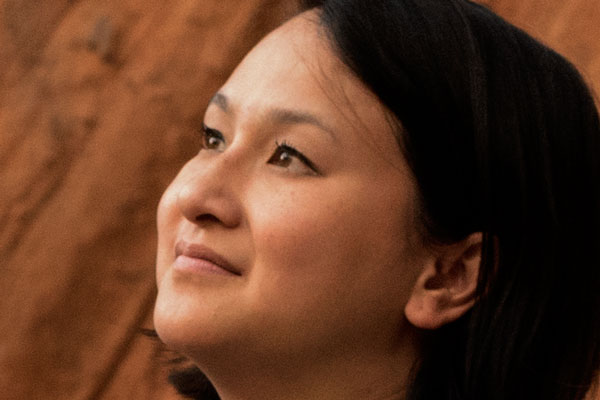
Dawning of a New Era of Diversity?
Despite dismal headlines about the racial divisiveness of the United States, several long-term trends point to a future more mature culture of diversity and cooperation.
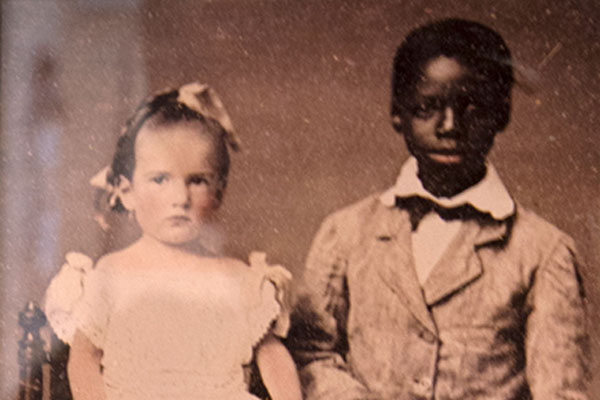
The History of Race in America
The racial history of the United States belongs to us all, with the responsibility to resolve the accompanying outstanding problems.
